Ontology-Based Representation and Reasoning in Building Construction Cost Estimation in China
Abstract
:1. Introduction
2. Research Background
2.1. BIM-Oriented Construction Cost Estimation
2.2. Ontology Modeling and Representation
3. The Building Cost Estimation Ontology Model
3.1. Ontology Representation Model
3.1.1. Concept Model Ontology
3.1.2. Work Item Ontology
3.1.3. Construction Condition Ontology
3.1.4. Heterogeneous Information Integration and Semantic Disambiguation
Heterogeneous Information Integration
Semantic Disambiguation
3.1.5. Integration Architecture of the Building Construction Cost Estimation Model
3.2. Reasoning Mechanism
Rule 1: Building_Product(?x) ∧ Material_Feature(?y) ∧ Building_Material(?z) ∧ havingMaterialFeature(?x,
?y) ∧ consistsOf(?y, ?z) ∧ included material(?x, ?z) → includesBuildingMaterial(?x, ?z)
3.3. Framework of the Building Construction Cost Estimation Based on Ontology
4. Implementation of the Building Construction Cost Estimation Ontology
4.1. Software Environment
4.2. The Transformation System Framework of Cost Estimation
(deftemplate owl:Thing(slot name))(deftemplate Cost_Estimation extends owl:Thing)(deftemplate
Concept_Model extends Cost_Estimation)(deftemplate Building_Product extends
Concept_Model)(deftemplate Beam extends Building_Product)
(assert(owl:thing(name Rectangular_Beam))) (assert(Cost_Estimation(name Rectangular_Beam )))
(assert(Concept_Model (name Rectangular_Beam))) (assert(Building_Product (name Rectangular_Beam)))
(assert(Beam(name Rectangular_Beam)))
(assert(havingMaterialFeature Rectangular_Beam_of_Cast-in-Place_Concrete)
(defrule Rule(Building_Product(name ?x))(Material_Feature(name ?y))(havingMaterialFeature ?x
?y)(Building_Material(name ?z))(consistsOf ?y ?z)=>(includesBuildingMaterial ?x ?z))
5. Experiment of Cost Estimation Ontology Reasoning
5.1. Execution of Interation Reasoning
Rule 2: Beam(?x)∧Geometry_Feature(?y)∧Material_Feature(?z)∧hasMaterialFeature(?x, Cast-in-
Place_Concrete)∧hasSectionShape(?x, rectangular)→representsBuildingProduct (id_010503002, ?x)
Rule 3: Beam(?x)∧Material_Feature(?y) ∧Building_Material(?z)∧hasMaterialFeature(Rectangular_Beam,
Cast_In_Place_Concrete)∧ consistsOf (Cast_In_Place_Concrete, ?z) →includesBuildingMaterial
(Rectangular_Beam, ?z)
Rule 4: Building_Product(?x) ∧ IFC(?y) ∧ BIM_Model(?z) ∧ isSimilarTo (?x, ?y) ∧ isPartOf (?y, ?z) →
belongTo(?x, ?z)
5.2. A Case Application
Rule 5: Building_Product(?x) ∧ Material_Feature(?y) ∧ Geometry_Feature(?z) ∧ Strength_Grade(?a) ∧
hasMaterialFeature(Concrete_Beam, Cast-in-Place_Concrete) ∧ hasSectionShape(Concrete_Beam, Ring) ∧
hasStrengthGrade(Concrete_Beam, C20) ∧ Building_Component(?b)->
hasSubCostItem(Ring_Beam_C20_of_Cast-in-Place_Concrete, ID_010503004001)
6. Conclusions
- The hierarchical classification and reasoning rules are defined on the basis of GB 50500 and the terminology standard. This research solves the problem of localized standards by combining GB 50500 and the internationally accepted taxonomy standard.
- The cost estimation ontology has the advantages of both consistency and clarity in its structure and concepts of expression. OWL can perfectly represent the knowledge of building construction cost estimation, and the ontology is convenient for sharing and reusing building construction cost estimation knowledge.
- Reasoning rules can be described by SWRL in the building construction cost estimation ontology. Through the combination of SWRL and Jess inference engine, the reasoning results of cost estimation can be reasoned automatically.
- This research demonstrates that the proposed ontologies and semantic reasoning rules can be utilized to facilitate cost estimation of concept and taxonomy structures in the proposed ontology.
- Due to the powerful expansibility of the cost estimation ontology model, the cost information and rules in this proposed method can be continuously updated and expanded in practice, and automatic reasoning and integration of information can be realized.
Acknowledgments
Author Contributions
Conflicts of Interest
References
- Ma, Z.; Wei, Z.; Zhang, X. Semi-automation and specification-compliant cost estimation for tendering of building projects based on IFC data of design model. Autom. Constr. 2013, 30, 126–135. [Google Scholar] [CrossRef]
- Sabol, L. Challenges in cost estimating with building information modeling. Ifma Work Workplace. 2008. Available online: http://dcstrategies.net/files/2_sabol_cost_estimating.pdf (accessed on 15 February 2016).
- BuildingSMART International Ltd. IFC Overview. Available online: http://www.buildingsmart-tech.org/specifications/ifc-overview (accessed on 15 February 2016).
- ToCoMan. Tocosoft. Available online: http://www.tocoman.com/ (accessed on 15 February 2016).
- Estimator. Graphisoft. Available online: http://www.graphisoft.com/archicad/ (accessed on 15 February 2016).
- Staub-French, S.; Fischer, M.; Kunz, J.; Paulson, B. An ontology for relating features with activities to calculate costs. J. Comput. Civ. Eng. 2003, 17, 243–254. [Google Scholar] [CrossRef]
- Lee, S.; Kim, K.; Yu, J. BIM and ontology-based approach for building cost estimation. Autom. Constr. 2014, 14, 96–105. [Google Scholar] [CrossRef]
- Eastman, C.; Teicholz, P.; Sacks, R.; Liston, K. BIM Handbook: A Guide to Building Information Modeling for Owners, Managers, Designers, Engineers and Contractors; John Wiley & Sons: New York, NY, USA, 2011. [Google Scholar]
- National Institute of Building Sciences. National BIM Standard-United States Version 2. Available online: http://www.nationalbimstandard.org/ (accessed on15 February 2016).
- Vico Estiamator, Inc. Viso Software. Available online: http://www.vicosoftware.com/ (accessed on 15 February 2016).
- Innovaya. Innovaya Visual Estimating. Available online: http://www.innovaya.com/prod_ov.htm (accessed on 15 February 2016).
- Success Estimator. U.S.COST. Available online: http://www.uscost.com/success/ (accessed on 15 February 2016).
- Faraj, I.; Alshawi, M.; Aouad, G.; Child, T.; Underwood, J. An industry foundation classes Web-based collaborative construction computer environment: WISPER. Autom. Constr. 2002, 10, 79–99. [Google Scholar] [CrossRef]
- Staub-French, S.; Fischer, M.; Kunz, J.; Paulson, B. A generic feature-driven activity-based cost estimation process. Adv. Eng. Inform. 2003, 17, 23–39. [Google Scholar] [CrossRef]
- Fu, C.; Ghassan, A.; Amanda, M.P.; Lee, A.; Wu, S. IFC implementation in lifecycle costing. J. Harbin Inst. Technol. 2004, 11, 437–441. [Google Scholar]
- Yabuki, N.; Tomoaki, S. A management system for cut and fill earthworks based on 4D CAD and EVMS. In Proceedings of the International Conference on Computing in Civil Engineering 2005, Cancun, Mexico, 12–15 July 2005; pp. 1–8.
- Ma, Z.; Wei, Z.; Song, W.; Lou, Z. Application and extension of the IFC standard in construction cost estimating for tendering in China. Autom. Constr. 2011, 20, 196–204. [Google Scholar]
- Ma, Z.L.; Zhang, X.D.; Wu, S.; Wei, Z.H.; Lou, Z. Framework design for BIM-based construction cost estimating software. In Proceedings of the CIB W78 27th International Conference, Cairo, Egypt, 16–18 November 2010.
- Ma, Z.; Wei, Z.; Zhang, X.; Qiu, S.; Wang, P. Intelligent generation of bill of quantity from IFC data subject to Chinese standard. In Proceedings of the 28th ISARC, Seoul, Korea, 29 June–2 July 2011; pp. 740–745.
- Lee, T.B.; Hendler, J.; Lassila, O. The Semantic Web. Sci. Am. Mag. 2001, 284, 34–43. [Google Scholar]
- Gruber, T.R. A translation approach to portable ontology specifications. Knowl. Acquis. 1993, 5, 199–220. [Google Scholar] [CrossRef]
- Guarino, N. Formal ontology and information systems. In Proceedings of the 1st International Conference on Formal Ontology in Information Systems, Trento, Italy, 6–8 June 1998; pp. 3–15.
- Zhu, Y.; Mao, W.; Ahmad, I. Capturing implicit structures in unstructured content of construction documents. J. Comput. Civ. Eng. 2007, 21, 220–227. [Google Scholar] [CrossRef]
- El-Diraby, T.E.; Osman, H. A domain ontology for construction concepts in urban infrastructure products. Autom. Constr. 2011, 20, 1120–1132. [Google Scholar] [CrossRef]
- Tserng, H.P.; Yin, S.Y.L.; Dzeng, R.J.; Wou, B.; Tsai, M.D.; Chen, W.Y. A study of ontology-based risk management framework of construction projects through project life cycle. Autom. Constr. 2009, 18, 994–1008. [Google Scholar] [CrossRef]
- Hsieh, S.H.; Lin, H.T.; Chi, N.W.; Chou, K.W.; Lin, K.Y. Enabling the development of base domain ontology through extraction of knowledge from engineering domain handbooks. Adv. Eng. Inform. 2011, 25, 288–296. [Google Scholar] [CrossRef]
- Wang, H.H.; Boukamp, F. Ontology-based approach to context representation and reasoning for managing context-sensitive construction information. J. Comput. Civ. Eng. 2011, 25, 331–346. [Google Scholar] [CrossRef]
- Wang, H.H.; Boukamp, F. Ontology-based representation and reasoning framework for supporting job hazard analysis. J. Comput. Civ. Eng. 2011, 25, 442–456. [Google Scholar] [CrossRef]
- Zhang, S.; Boukamp, F.; Teizer, J. Ontology-based semantic modeling of safety management knowledge. In Proceedings of the 2014 International Conference on Computing in Civil and Building Engineering, Orlando, FL, USA, 23–25 June 2014; pp. 2254–2262.
- Abanda, F.H.; Tah, J.H.M.; Manjia, M.; Pettang, C. An ontology-driven house-building labour cost estimation in Cameroon. J. Inf. Technol. Constr. 2011, 16, 617–634. [Google Scholar]
- Abanda, H.; Tah, J.H.M.; Pettang, C.; Manjia, M.B.; Sambo, K. An ontology-driven approach to labour cost estimation: The case of house-building projects in Cameroon. In Proceedings of the Computing in Civil and Building Engineering, The University of Nottingham, Nottingham, UK, 30 June–2 July 2010; pp. 225–231.
- Abanda, F.H.; Kamsu-Foguem, B.; Tah, J. Towards an Intelligent Ontology Construction Cost Estimation System: Using BIM and New Rules of Measurement Techniques. World Acad. Sci. Eng. Technol. Int. J. Comput. Electr. Autom. Control Inf. Eng. 2015, 9, 294–299. [Google Scholar]
- Noy, N.F.; Mc Guinness, D.L. Ontology Development 101: A Guide to Creating Your First Ontology; Stanford University: Stanford, CA, USA, 2001. [Google Scholar]
- Zhang, J. A Social Semantic Web System for Coordinating Communication in the Architecture, Engineering & Construction Industry. Ph.D. Thesis, University of Toronto, Toronto, ON, Canada, 2011. [Google Scholar]
- Gómez-Pérez, A.; Fernández-López, M.; Corcho, O. Ontological Engineering with Examples from the Areas of Knowledge Management, e-Commerce and the Semantic Web; Springer Science and Business Media: London, UK, 2004. [Google Scholar]
- Code of Valuation with Bill Quantity of Construction; National Ministry of Housing and Urban-Rural Development of China: Beijing, China, 2013.
- CSI (Construction Specifications Institute). MasterFormat. Available online: http://www.csinet.org/masterformat (accessed on 16 February 2016).
- Charette, R.P.; Marshall, H.E. UNIFORMAT II Elemental Classification for Building Specifications, Cost Estimating, and Cost Analysis; U.S. Department of Commerce: Springfield, VA, USA, 1999.
- CSI (Construction Specifications Institute). Omniclass [EB/OL]. Available online: http://www.omniclass.org/ (accessed on 16 February 2016).
- Wang, H.H.; Boukamp, F. A context ontology development process for construction safety. In Joint CIB Conference: W102 Information and Knowledge Management in Building and W096 Architectural Management; International Council for Research and Innovation in Building and Construction (CIB): Rotterdam, The Netherlands, 2008; pp. 297–308. [Google Scholar]
- Neelameghan, A.; Maitra, R. Non-Hierarchical Associative Relationships among Concepts: Identification and Typology; Documentation Research and Training Centre: Bangalore, India, 1978. [Google Scholar]
- Yoo, J.; Bieber, M. Towards a relationship navigation analysis. In Proceedings of the 33rd Hawaii International Conference on System Sciences, Washington, DC, USA, 4–7 January 2000.
- Schuette, S.D.; Liska, R.W. Building Construction Estimating; McGraw-Hill: New York, NY, USA, 1994. [Google Scholar]
- BauDataWeb. FreeClassOWL Ontology. Available online: http://semantic.eurobau.com/ (accessed on 16 February 2016).
- El-Gohary, N.M.; El-Diraby, T.E. Domain Ontology for Processes in Infrastructure and Construction. J. Constr. Eng. Manag. 2010, 136, 730–744. [Google Scholar] [CrossRef]
- The GR Ontology. Available online: http://www.heppnetz.de/ontologies/goodrelations/v1.html (accessed on 16 February 2016).
- Lima, C.; El-Diraby, T.; Stephens, J. Ontology-based optimization of knowledge management in e-construction. ITcon 2005, 10, 305–327. [Google Scholar]
- Hebeler, J.; Fisher, M.; Blace, R.; Perez-Lopez, A. Semantic Web Programming; John Wiley & Sons: New York, NY, USA, 2009. [Google Scholar]
- Kay, M. XSL Transformations (XSLT) Version 3.0. Available online: http://www.w3.org/TR/xslt-30/ (accessed on 17 February 2016).
- Jovanovic, J.; Gasevic, D. Achieving knowledge interoperability: An XML/XSLT approach. Expert Syst. Appl. 2005, 29, 535–553. [Google Scholar] [CrossRef]
- BuildingSMART. IFD Library for Building SMART. Available online: http://dev.ifd-library.org/index.php/Main_Page (accessed on 17 February 2016).
- Hoorrocks, I.; Patel-Schneider, P.F.; Boley, H.; Tabet, S.; Grosof, B.; Dean, M. SWRL: A Semantic Web Rule Language Combining OWL and RuleML. Available online: http://www.w3.org/Submission/SWRL/ (accessed on 17 February 2016).
- Beimel, D.; Peleg, M. Using OWL and SWRL to represent and reason with situation-based access control policies. Data Knowl. Eng. 2011, 70, 596–615. [Google Scholar] [CrossRef]
- Aalto University, Ugent University (MultiMediaLab—SmartLab). IFC-to-RDF Converter. Service. Available online: http://multimedialab.elis.ugent.be/organon/ifc/ (accessed on 17 February 2016).
- Stanford Center for Biomedical Informatics Research. The Protégé Ontology Editor and Knowledge Acquisition System. Available online: http://protege.stanford.edu/ (accessed on 17 February 2016).
- Horridge, M.; Knublauch, H.; Rector, A.; Stevens, R.; Wroe, C. A Practical Guide to Building OWL Ontologies Using the Protégé-OWL Plugin and CO-ODE Tools; Springer: Berlin/Heidelberg, Germany, 2004. [Google Scholar]
- Ernest Friedman-Hill. Jess, The Expert System Shell for the Java Platform. Available online: http://www.jessrules.com/jess/index.shtml (accessed on 17 February 2016).
- Niknam, M.; Karshenas, S. A semantic web service approach to construction cost estimation. Comput. Civ. Eng. 2013, 484–491. [Google Scholar] [CrossRef]
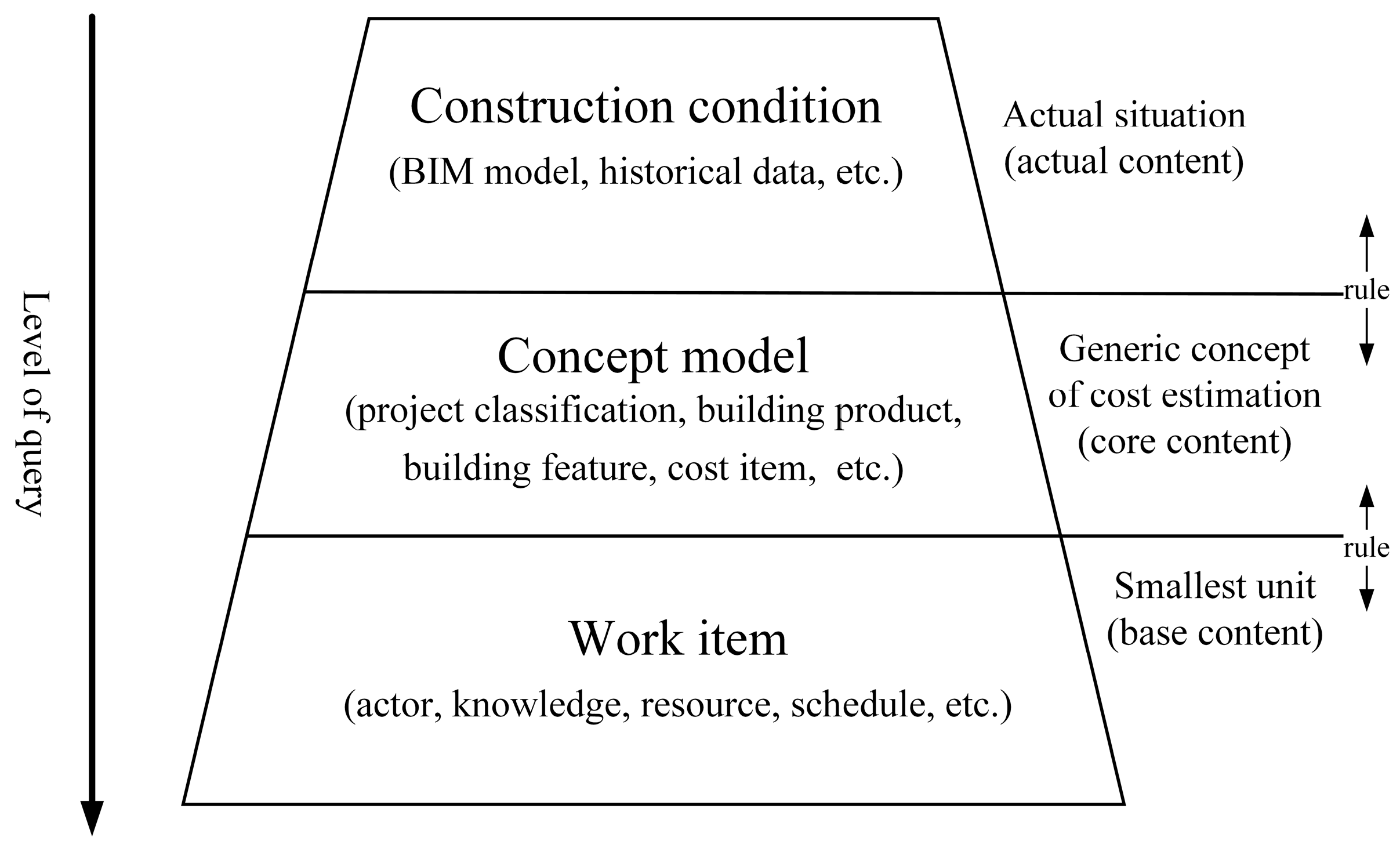


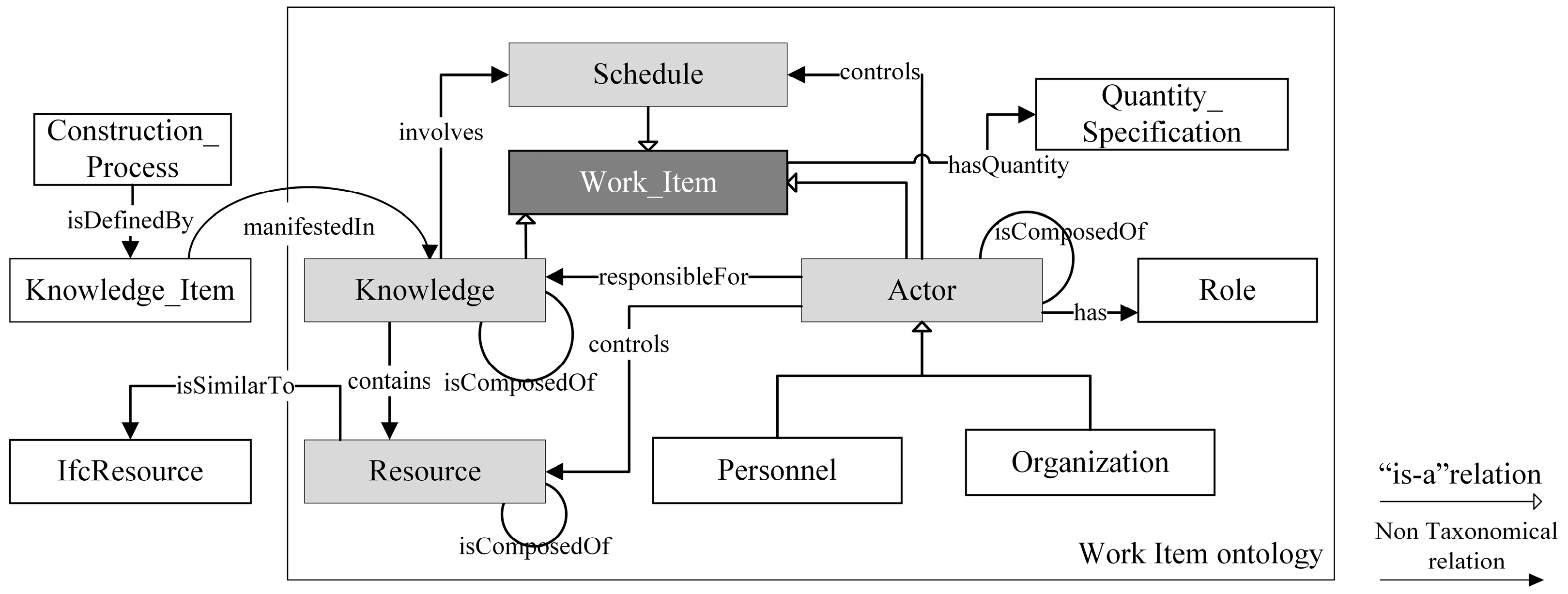



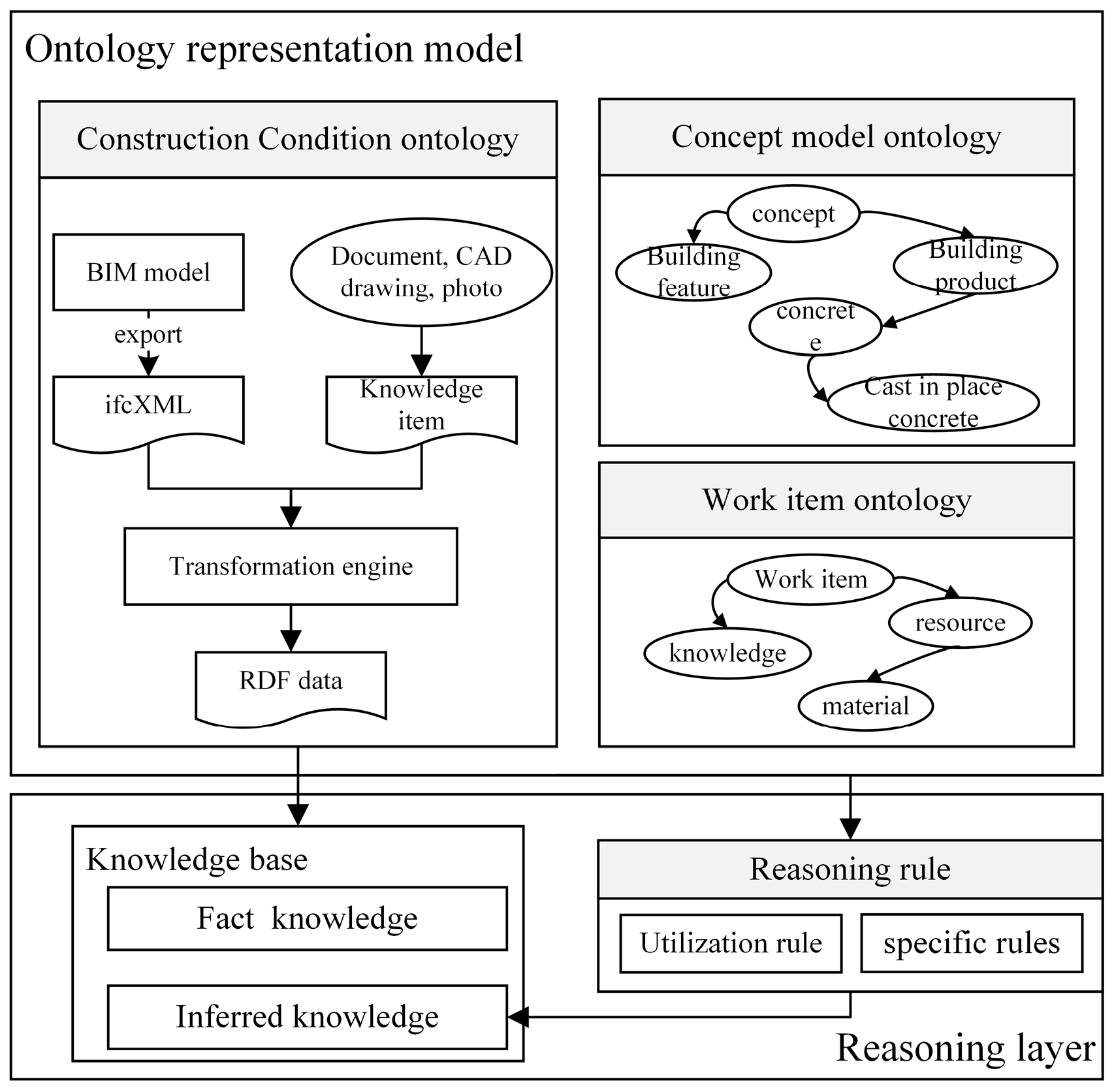
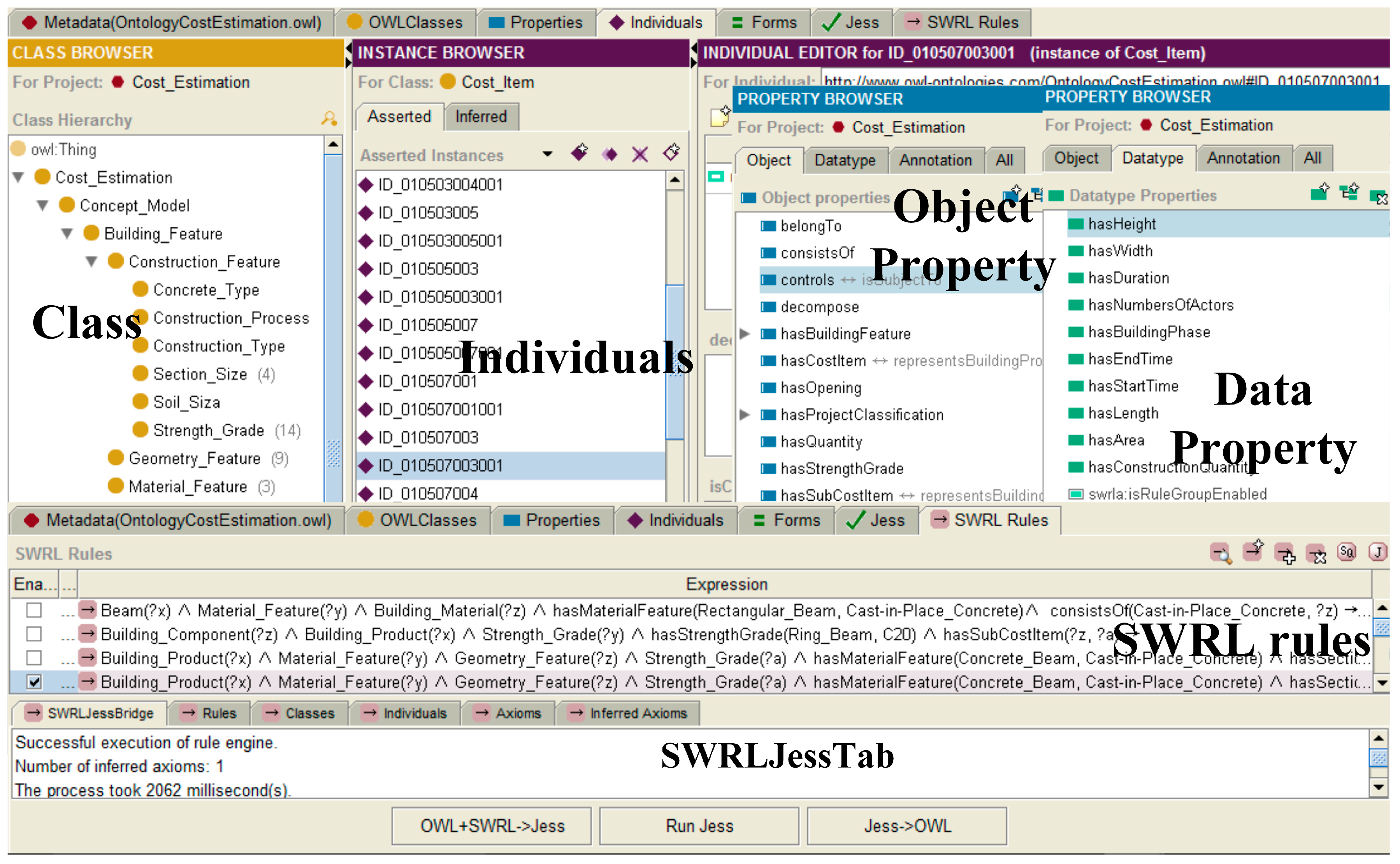

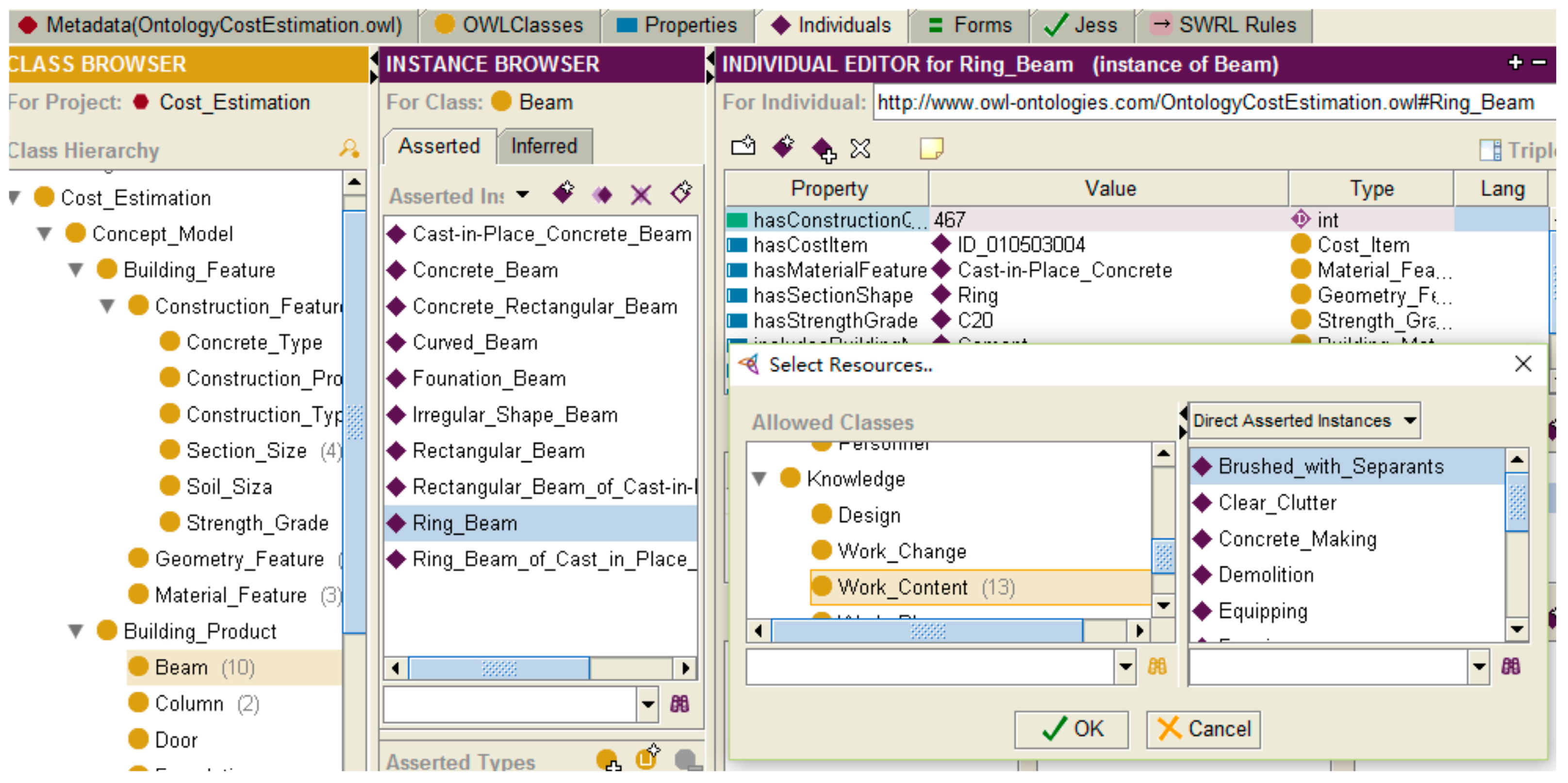
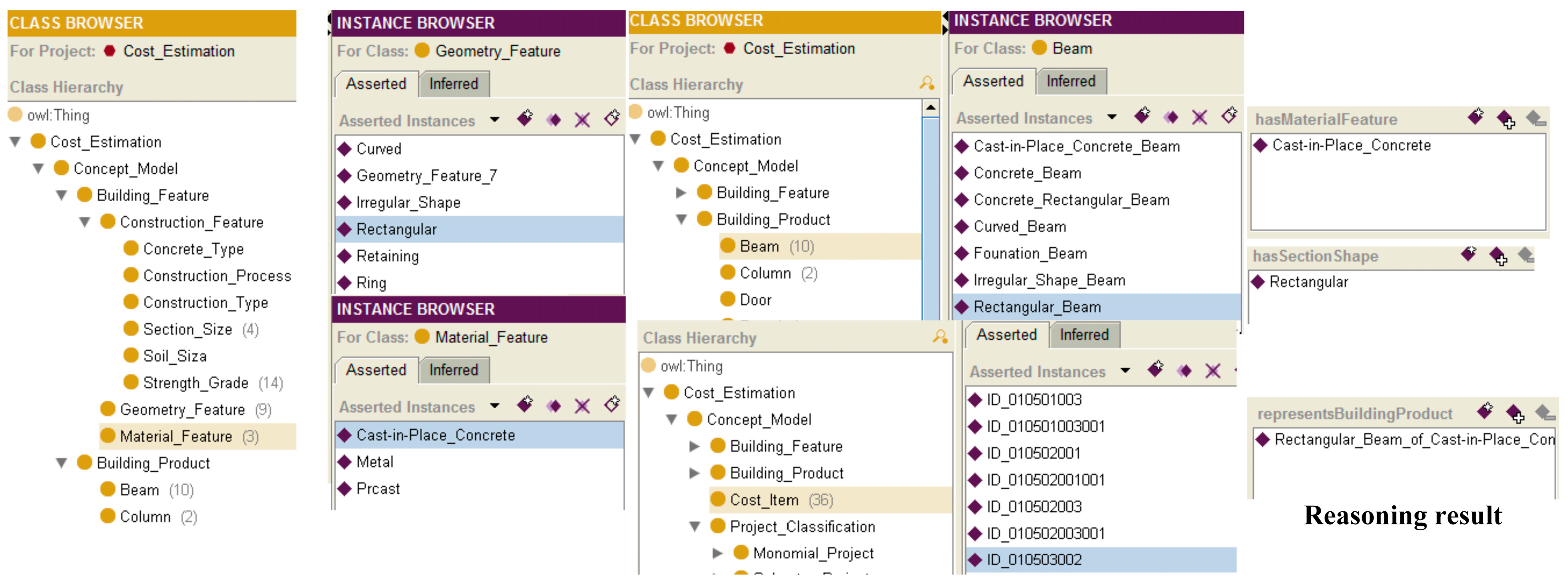
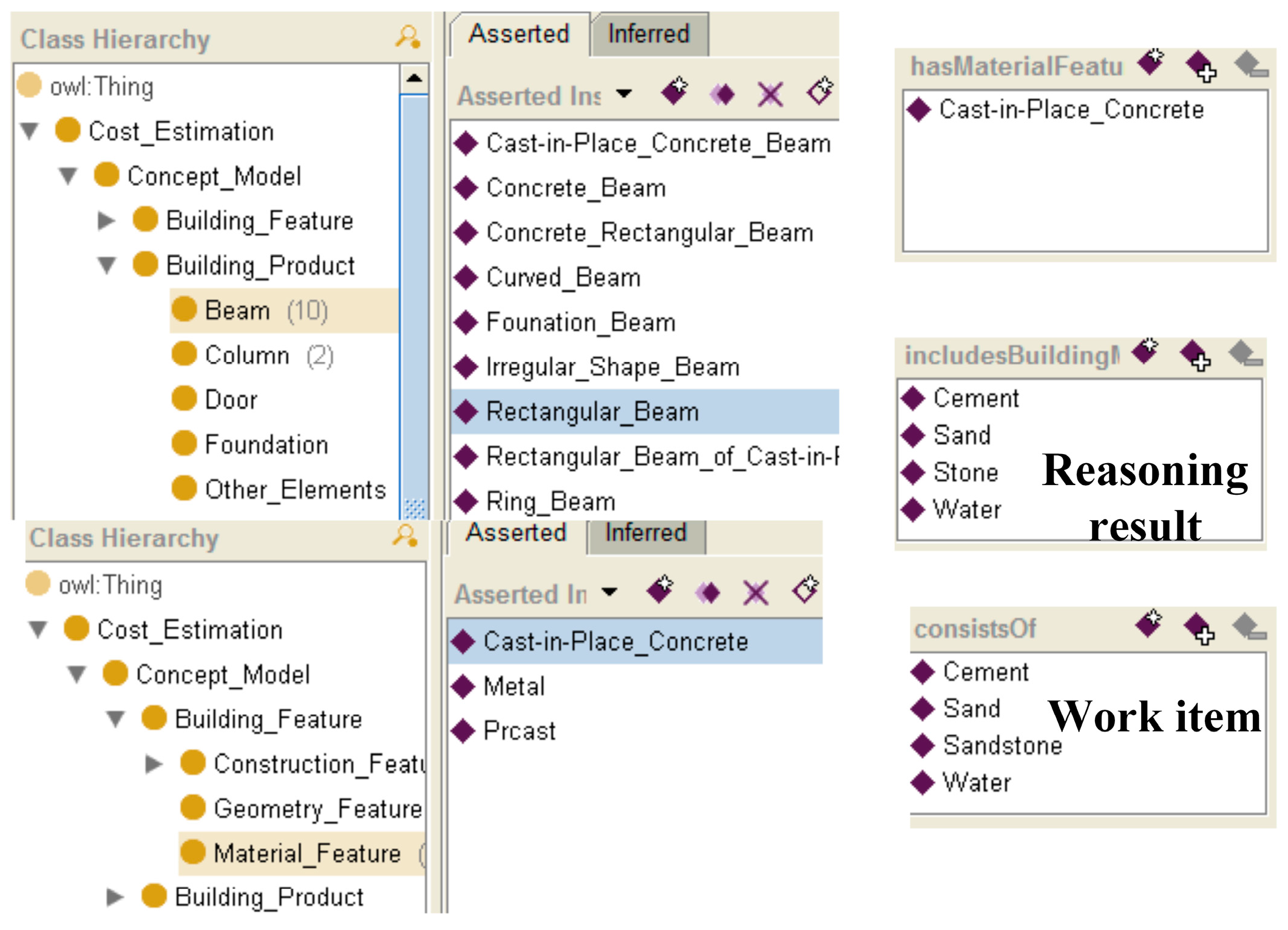



| No. of Cost Item | Description 1 in Chinese | Description 2 in Chinese | Standard Description in English | Description 1 in English | Description 2 in English |
|---|---|---|---|---|---|
| 0105 | 混凝土 | 砼 | concrete | conc | con‘c |
| 010502001 | 矩形柱 | 长方形柱 | rectangular column | - | - |
| 010809002 | 铝塑窗台板 | 铝塑板窗台 | aluminum-plastic sill | - | - |
| Object Property | Domain | Range | Note |
|---|---|---|---|
| isPartOf | IFC | BIM | The relationship between BIM and IFC. |
| controls | Actor | Resource | The relationship between actors and resources that it controls. |
| hasMaterialFeature | Building_Product | Material_Feature | The relationship between a building product and material feature |
| hasOpening | Building_Product | Building_Product | The relationship among building products, and its space relationship between building product and building product. |
| decompose | Construction_Condition | Concept_Model | The relationship between a construction condition and the concept that it involves. |
| isSimilarTo | Building_Product | IfcBuildingProduct | The relationship between a building product and IFC entities IfcBuildingProduct |
| hasQuantity | Work_Item | Quality_Specification | The relationship between work items and quality specification. |
| responsibleFor | Actor | Knowledge | The relationship between an actor and what it is responsible for. |
| hasSectionShape | Building_Product | Geometry_Feature | The relationship between a building product and a geometry feature. |
| hasCostItem | Building_Product | Cost_Item | The relationship between a building product and a cost item. |
| OWL/SWRL | Jess |
|---|---|
| Class, property, individual | Facts |
| RDF, OWL, SWRL semantics | Rules |
| Data Type Property in OWL | Jess Type |
|---|---|
| xsd: string | RU.STRING |
| xsd: boolean | The atoms “TRUE” and “FALSE” |
| xsd: decimal, xsd: double, xsd: int, xsd: long, etc. | RU.INTEGER, RU.FLOAT, RU LONG |
| ARRAY_XX_TYPE class, etc. | A Jess multifield |
© 2016 by the authors; licensee MDPI, Basel, Switzerland. This article is an open access article distributed under the terms and conditions of the Creative Commons Attribution (CC-BY) license (http://creativecommons.org/licenses/by/4.0/).
Share and Cite
Liu, X.; Li, Z.; Jiang, S. Ontology-Based Representation and Reasoning in Building Construction Cost Estimation in China. Future Internet 2016, 8, 39. https://doi.org/10.3390/fi8030039
Liu X, Li Z, Jiang S. Ontology-Based Representation and Reasoning in Building Construction Cost Estimation in China. Future Internet. 2016; 8(3):39. https://doi.org/10.3390/fi8030039
Chicago/Turabian StyleLiu, Xin, Zhongfu Li, and Shaohua Jiang. 2016. "Ontology-Based Representation and Reasoning in Building Construction Cost Estimation in China" Future Internet 8, no. 3: 39. https://doi.org/10.3390/fi8030039






